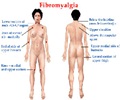The findings of a pilot study provide promising preliminary support for the beneficial effects of yoga in patients with Fibromyalgia.

Given the much higher prevalence of FM in females (80%), researchers chose to include only women in this study. 53 women at least 21 years of age participated. To be eligible, patients had to meet the following criteria: be diagnosed with FM by American College of Rheumatology (ACR) criteria for at least 1 year and be on a stable regimen of pharmacologic and/or non-pharmacologic treatment for FM for at least 3 months. The patients were randomized; 25 participated in the Yoga of Awareness program, while 28 received standard care.
Yoga of Awareness is an innovative, comprehensive yoga program, which for the purposes of this study was tailored to address pain, fatigue, sleep disturbance, and emotional distress in FM. Each Yoga of Awareness class included approximately 40 minutes of gentle stretching poses, 25 minutes of mindfulness meditation (e.g., awareness of breath, awareness of awareness itself), 10 minutes of breathing techniques (e.g., full yogic breath, breathing into sensation), 20 minutes of didactic presentations on the application of yogic principles to optimal coping, and 25 minutes of group discussions (e.g., experiences while practicing yoga at home).
After the yoga program was completed, both groups were assessed for fibromyalgia symptoms and functional deficits, overall improvement in fibromyalgia symptoms, physical tests of fibromyalgia symptoms and functional deficits such as tender points, strength and balance deficits, and a number of pain coping strategies.
Following treatment, women assigned to the yoga program showed significantly greater improvements on standardized measures of FM symptoms and functioning, including pain, fatigue, and mood, and in pain catastrophizing, acceptance, and other coping strategies.
Dr. Carson and colleagues observed, "In addition, the results suggested the yoga intervention led to a beneficial shift in how patients cope with pain, including greater use of adaptive pain coping strategies (i.e., problem solving, positive reappraisal, use of religion, activity engagement despite pain, acceptance, relaxation) and less use of maladaptive strategies (i.e., catastrophizing, self-isolation, disengagement, confrontation)."
Advertisement
Source-Eurekalert














